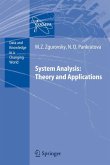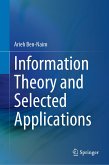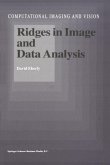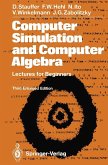Alexander S. Mikhailov, Alexander Yu. Loskutov
Foundations of Synergetics II (eBook, PDF)
Chaos and Noise
40,95 €
40,95 €
inkl. MwSt.
Sofort per Download lieferbar

20 °P sammeln
40,95 €
Als Download kaufen

40,95 €
inkl. MwSt.
Sofort per Download lieferbar

20 °P sammeln
Jetzt verschenken
Alle Infos zum eBook verschenken
40,95 €
inkl. MwSt.
Sofort per Download lieferbar
Alle Infos zum eBook verschenken

20 °P sammeln
Alexander S. Mikhailov, Alexander Yu. Loskutov
Foundations of Synergetics II (eBook, PDF)
Chaos and Noise
- Format: PDF
- Merkliste
- Auf die Merkliste
- Bewerten Bewerten
- Teilen
- Produkt teilen
- Produkterinnerung
- Produkterinnerung

Bitte loggen Sie sich zunächst in Ihr Kundenkonto ein oder registrieren Sie sich bei
bücher.de, um das eBook-Abo tolino select nutzen zu können.
Hier können Sie sich einloggen
Hier können Sie sich einloggen
Sie sind bereits eingeloggt. Klicken Sie auf 2. tolino select Abo, um fortzufahren.

Bitte loggen Sie sich zunächst in Ihr Kundenkonto ein oder registrieren Sie sich bei bücher.de, um das eBook-Abo tolino select nutzen zu können.
The subject of chaos and, in particular, the complex chaotic patterns that can arise in distributed active systems are topics that are currently attracting much attention from various branches of science. This book and its partner volume I offer an excellent introduction to the basic theory of cooperative behavior in distributed active systems and are written at a level that is accessible to undergraduates. The second edition is essentially revised and enlarged.
- Geräte: PC
- ohne Kopierschutz
- eBook Hilfe
- Größe: 27.84MB
Andere Kunden interessierten sich auch für
![Coupled Boundary and Finite Element Methods for the Solution of the Dynamic Fluid-Structure Interaction Problem (eBook, PDF) Coupled Boundary and Finite Element Methods for the Solution of the Dynamic Fluid-Structure Interaction Problem (eBook, PDF)]() Siamak AminiCoupled Boundary and Finite Element Methods for the Solution of the Dynamic Fluid-Structure Interaction Problem (eBook, PDF)72,95 €
Siamak AminiCoupled Boundary and Finite Element Methods for the Solution of the Dynamic Fluid-Structure Interaction Problem (eBook, PDF)72,95 €![System Analysis: Theory and Applications (eBook, PDF) System Analysis: Theory and Applications (eBook, PDF)]() Mikhail Z. ZgurovskySystem Analysis: Theory and Applications (eBook, PDF)160,95 €
Mikhail Z. ZgurovskySystem Analysis: Theory and Applications (eBook, PDF)160,95 €![Information Theory and Selected Applications (eBook, PDF) Information Theory and Selected Applications (eBook, PDF)]() Arieh Ben-NaimInformation Theory and Selected Applications (eBook, PDF)160,95 €
Arieh Ben-NaimInformation Theory and Selected Applications (eBook, PDF)160,95 €![Information Theory (eBook, PDF) Information Theory (eBook, PDF)]() Arieh Ben-NaimInformation Theory (eBook, PDF)160,95 €
Arieh Ben-NaimInformation Theory (eBook, PDF)160,95 €![Smart Modelling For Engineering Systems (eBook, PDF) Smart Modelling For Engineering Systems (eBook, PDF)]() Smart Modelling For Engineering Systems (eBook, PDF)160,95 €
Smart Modelling For Engineering Systems (eBook, PDF)160,95 €![Ridges in Image and Data Analysis (eBook, PDF) Ridges in Image and Data Analysis (eBook, PDF)]() D. EberlyRidges in Image and Data Analysis (eBook, PDF)72,95 €
D. EberlyRidges in Image and Data Analysis (eBook, PDF)72,95 €![Computer Simulation and Computer Algebra (eBook, PDF) Computer Simulation and Computer Algebra (eBook, PDF)]() Dietrich StaufferComputer Simulation and Computer Algebra (eBook, PDF)72,95 €
Dietrich StaufferComputer Simulation and Computer Algebra (eBook, PDF)72,95 €-
-
-
The subject of chaos and, in particular, the complex chaotic patterns that can arise in distributed active systems are topics that are currently attracting much attention from various branches of science. This book and its partner volume I offer an excellent introduction to the basic theory of cooperative behavior in distributed active systems and are written at a level that is accessible to undergraduates. The second edition is essentially revised and enlarged.
Dieser Download kann aus rechtlichen Gründen nur mit Rechnungsadresse in A, B, BG, CY, CZ, D, DK, EW, E, FIN, F, GR, HR, H, IRL, I, LT, L, LR, M, NL, PL, P, R, S, SLO, SK ausgeliefert werden.
Produktdetails
- Produktdetails
- Verlag: Springer Berlin Heidelberg
- Seitenzahl: 278
- Erscheinungstermin: 8. März 2013
- Englisch
- ISBN-13: 9783642801969
- Artikelnr.: 53173976
- Verlag: Springer Berlin Heidelberg
- Seitenzahl: 278
- Erscheinungstermin: 8. März 2013
- Englisch
- ISBN-13: 9783642801969
- Artikelnr.: 53173976
- Herstellerkennzeichnung Die Herstellerinformationen sind derzeit nicht verfügbar.
The subject of chaos and, in particular, the complex chaotic patterns that can arise in distributed active systems are topics that are currently attracting much attention from various branches of science. This book and its partner volume I offer an excellent introduction to the basic theory of cooperative behavior in distributed active systems and are written at a level that is accessible to undergraduates. The second edition is essentially revised and enlarged.
1. Introduction.- 1.1 Chaotic Dynamics.- 1.2 Noise-Induced Complex Patterns.- 1.3 Chaos, Noise, and Self-Organization.- 2. Unpredictable Dynamics.- 2.1 Hamiltonian Systems.- 2.2 Destruction of Tori.- 2.3 Ergodicity and Mixing.- 3. Strange Attractors.- 3.1 Dissipative Systems and Their Attractors.- 3.2 The Lorenz Model.- 3.3 Lyapunov Exponents.- 3.4 The Autocorrelation Function.- 4. Fractals.- 4.1 Self-Similar Patterns.- 4.2 Fractal Dimensions.- 4.3 Dimensions of Strange Attractors and Fractal Basin Boundaries.- 5. Iterative Maps.- 5.1 Fixed Points and Cycles.- 5.2 Chaotic Maps.- 5.3 Feigenbaum Universality.- 6. Routes to Temporal Chaos.- 6.1 Bifurcations.- 6.2 The Ruelle-Takens Scenario.- 6.3 Period Doubling.- 6.4 Intermittency.- 6.5 Controlling Chaotic Behavior.- 7. Spatiotemporal Chaos.- 7.1 Analysis of Time Series.- 7.2 Turbulence in Distributed Active Systems.- 7.3 Coupled Chaotic Maps.- 7.4 The Complex Ginzburg-Landau Equation.- 7.5 Statistics of Defects.- 7.6 Transient Turbulence.- 8. Random Processes.- 8.1 Probabilistic Automata.- 8.2 Continuous Random Processes.- 8.3 The Fokker-Planck Equation.- 9. Active Systems with Noise.- 9.1 Generalized Brownian Motion.- 9.2 Internal Noise.- 9.3 Optimal Fluctuations and Transition Probabilities.- 10. Birth-Death Systems.- 10.1 Stochastic Birth-Death Models.- 10.2 The Ignition Problem.- 10.3 Spatiotemporal Intermittency in Population Explosions.- 10.4 Explosions in Media with Random Breeding Centers.- 11. Extinction and Complex Relaxation.- 11.1 Diffusion with Random Traps.- 11.2 Irreversible Annihilation.- 11.3 Conserved Quantities and Long-Time Relaxation.- 11.4 Stochastic Segregation.- 12. Nonequilibrium Phase Transitions.- 12.1 Second-Order Phase Transitions.- 12.2 Sweeping Through the Critical Region.- 12.3 The Biased Transition.- 12.4 Medium-Populating Transitions.- 12.5 Noise-Induced Phase Transitions: Competition and Coexistence in the Fluctuating Environment.- References.
1. Introduction.- 1.1 Chaotic Dynamics.- 1.2 Noise-Induced Complex Patterns.- 1.3 Chaos, Noise, and Self-Organization.- 2. Unpredictable Dynamics.- 2.1 Hamiltonian Systems.- 2.2 Destruction of Tori.- 2.3 Ergodicity and Mixing.- 3. Strange Attractors.- 3.1 Dissipative Systems and Their Attractors.- 3.2 The Lorenz Model.- 3.3 Lyapunov Exponents.- 3.4 The Autocorrelation Function.- 4. Fractals.- 4.1 Self-Similar Patterns.- 4.2 Fractal Dimensions.- 4.3 Dimensions of Strange Attractors and Fractal Basin Boundaries.- 5. Iterative Maps.- 5.1 Fixed Points and Cycles.- 5.2 Chaotic Maps.- 5.3 Feigenbaum Universality.- 6. Routes to Temporal Chaos.- 6.1 Bifurcations.- 6.2 The Ruelle-Takens Scenario.- 6.3 Period Doubling.- 6.4 Intermittency.- 6.5 Controlling Chaotic Behavior.- 7. Spatiotemporal Chaos.- 7.1 Analysis of Time Series.- 7.2 Turbulence in Distributed Active Systems.- 7.3 Coupled Chaotic Maps.- 7.4 The Complex Ginzburg-Landau Equation.- 7.5 Statistics of Defects.- 7.6 Transient Turbulence.- 8. Random Processes.- 8.1 Probabilistic Automata.- 8.2 Continuous Random Processes.- 8.3 The Fokker-Planck Equation.- 9. Active Systems with Noise.- 9.1 Generalized Brownian Motion.- 9.2 Internal Noise.- 9.3 Optimal Fluctuations and Transition Probabilities.- 10. Birth-Death Systems.- 10.1 Stochastic Birth-Death Models.- 10.2 The Ignition Problem.- 10.3 Spatiotemporal Intermittency in Population Explosions.- 10.4 Explosions in Media with Random Breeding Centers.- 11. Extinction and Complex Relaxation.- 11.1 Diffusion with Random Traps.- 11.2 Irreversible Annihilation.- 11.3 Conserved Quantities and Long-Time Relaxation.- 11.4 Stochastic Segregation.- 12. Nonequilibrium Phase Transitions.- 12.1 Second-Order Phase Transitions.- 12.2 Sweeping Through the Critical Region.- 12.3 The Biased Transition.- 12.4 Medium-Populating Transitions.- 12.5 Noise-Induced Phase Transitions: Competition and Coexistence in the Fluctuating Environment.- References.







